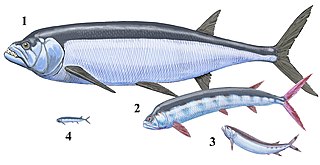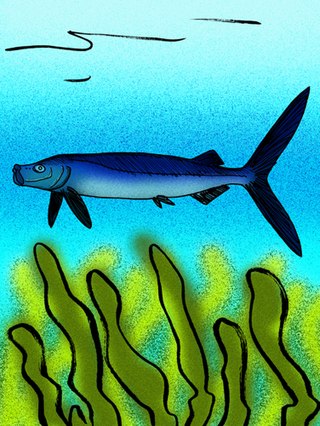
Berycopsis is an extinct genus of marine ray-finned fish from the Late Cretaceous period. Fossils are known from England, Germany, and Lebanon. A potential specimen is known from the Czech Republic.

Diplomystus is an extinct genus of freshwater and marine clupeomorph fish distantly related to modern-day extant herrings, anchovies, and sardines. It is known from the United States, China, and Lebanon from the Late Cretaceous to the middle Eocene. Many other clupeomorph species from around the world were also formerly placed in the genus, due to it being a former wastebasket taxon. It was among the last surviving members of the formerly-diverse order Ellimmichthyiformes, with only its close relative Guiclupea living for longer.

Ichthyodectiformes is an extinct order of marine stem-teleost ray-finned fish. The order is named after the genus Ichthyodectes, established by Edward Drinker Cope in 1870. Ichthyodectiforms are usually considered to be some of the closest relatives of the teleost crown group.
Cladocyclus is an extinct genus of marine ichthyodectiform ray-finned fish from the middle Cretaceous. It was a predator of about 1.20 metres (3.9 ft) in length.

Calamopleurus is a prehistoric genus of marine holostean ray-finned fish from the Early Cretaceous of South America and northern Africa. It was a relative of the modern bowfin, with both belonging to the family Amiidae.

Aphanepygus is an extinct genus of prehistoric marine holostean ray-finned fish that lived during the upper Cenomanian. It inhabited the former Tethys Ocean, with remains known from Lebanon and Croatia. Its exact affinities are uncertain, although it is usually recovered as a relative of the macrosemiids. However, other authorities recover it in the Ionoscopiformes.
Dactylopogon is an extinct genus of prehistoric marine ray-finned fish that lived during the Late Cretaceous. It contains a single species, D. grandis from the Campanian of the Ahlen Formation of Germany. It was previously considered a myctophiform, but more recent studies have found it to be an elopomorph. A second species, D. parvulus from the Cenomanian-aged Sannine Formation in Lebanon has also sometimes been placed in this genus.
Barcarenichthys is an extinct genus of prehistoric marine ray-finned fish that lived during the Late Cretaceous. It contains a single species, B. joneti, from the late Cenomanian of Portugal.
Casierius is an extinct genus of marine ray-finned fish that lived during the Albian stage of the Early Cretaceous epoch. It was a relative of the modern bonefish in the extinct family Phyllodontidae, although some authorities consider it either a true albulid or a very early eel. It contains a single species, C. heckeli, known from the Glen Rose Formation near Hood County, Texas.
Austroclupea is an extinct genus of freshwater ray-finned fish that lived during the Pliocene epoch. It contains a single species, A. zuninoi from Argentina. It was a relative of modern herring in the family Clupeidae.
Lualabaea is an extinct genus of prehistoric freshwater coelacanth, belonging to the family Mawsoniidae, from the Jurassic period. It contains two species, L. lericheiSaint-Seine, 1955 and L. henryiSaint-Seine, 1955, both known from the Stanleyville Formation of the Democratic Republic of the Congo. It may be related to or possibly synonymous with Axelrodichthys.

Anaethalion is an extinct genus of prehistoric marine and freshwater ray-finned fish related to modern tarpons and ladyfish. It is known from the Late Jurassic to the Early Cretaceous of Europe and northeasterrn Asia, roughly encompassing the Tethys Ocean.
Chardonius is an extinct genus of prehistoric freshwater ray-finned fish from the late Aptian or early Albian. It contains a single species, C. longicaudatus, from the Loia Beds of the Democratic Republic of the Congo.
Casieroides is an extinct genus of prehistoric freshwater ray-finned fish. It contains a single species, C. yamangaensis from the Early Cretaceous Loia Formation of the Democratic Republic of the Congo.
Occithrissops is an extinct genus of ray-finned fish of the Jurassic, described from Sundance Formation. The genus name of Occithrissops refers to the occidental occurrence of the genus and its relationship to Thrissops.
The Jinju Formation is an Early Cretaceous geologic formation in South Korea. Dinosaur remains are among the fossils that have been recovered from the formation, although none have yet been referred to a specific genus. The depositional age of this formation spans from approximately 112.4 ± 1.3 to 106.5 million years ago based on detrital zircon U-Pb dating. It predominantly consists of black shale, with sandstone packets, deposited in a fluvial-lacustrine setting.

Sinamia is an extinct genus of freshwater amiiform fish which existed in China, Japan, South Korea and North Korea during the Early Cretaceous period. Like the related bowfin, it has an elongated low-running dorsal fin, though this was likely convergently evolved.
The Tar Heel Formation, also known as the Coachman Formation in South Carolina, is a Late Cretaceous geologic formation in North Carolina and South Carolina, USA. It preserves fossils, including amber dating back to the Cretaceous period. A locality known as Phoebus Landing, has been dated to 78.5-77.1 Ma, and the formation has been overall dated to the early Campanian based on fossil pollen.

Wakinoichthys is a small freshwater fish from the Early Cretaceous of South Korea and Japan. Two species are currently known: W. aokii and W. robustus.

Amakusaichthys is an extinct genus of ichthyodectiform ray-finned fish which lived during the Late Cretaceous, known from only one species A. goshouraensis. Fossils are known from Kumamoto Prefecture in Japan.










